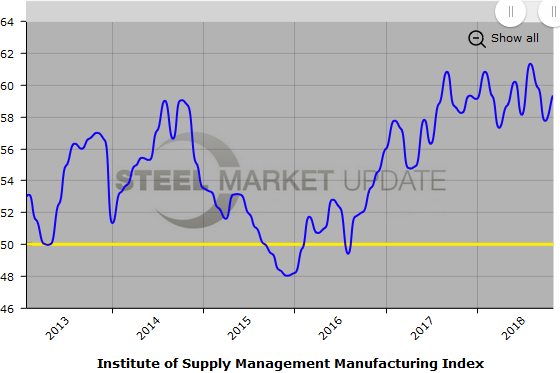Economy

ISM: Manufacturing Growth Slows as 2018 Ends
Written by Sandy Williams
January 3, 2019
Manufacturing activity in the U.S. continued to expand in December, but at a much lower pace, according to the latest ISM Report on Business. The December PMI fell 5.2 percentage points to 54.1 with indexes for new orders slipping 11 points and production slipping 5.3 points from November.
The average PMI score for 2018 was 58.8, with a high of 61.3 in August and a low of 54.1 in December. A reading above 50 indicates growth.
“Comments from the panel reflect continued expanding business strength, but at much lower levels,” said Timothy Fiore, chairman of the Institute for Supply Management’s Manufacturing Business Survey Committee. “Demand softened with the New Orders Index retreating to recent low levels, the Customers’ Inventories Index remaining too low — a positive heading into the first quarter of 2019 — and the Backlog of Orders declining to a zero-expansion level. Consumption continued to strengthen, with production and employment still expanding, but at much lower levels compared to prior periods. Inputs — expressed as supplier deliveries, inventories and imports — softened, as well, with suppliers improving delivery performance, and inventories and imports declining.”
New export orders were relatively consistent with the prior two months, said Fiore. The new export orders index registered 52.8, 0.6 percentage points higher than November, but at the lowest expansion level seen since late 2016. The Imports index registered 52.7, a decrease of 0.9 points for the month and the third month of softer expansion levels.
Price increases retreated to June 2017 levels, falling 5.8 points from November to a reading of 54.9.
“The Business Survey Committee noted that price increases are continuing to soften and/or decline in metals (steel and aluminum). Increases continue for freight, labor, electrical and electronic components, printed circuit board assemblies and products manufactured primarily from steel. Shortages continue for electrical and most electronic components. Aluminum, steel and caustic soda prices are down,” said Fiore.
Employment expanded in December for the 27th month, although decreasing 2.2 points to 56.2 from November.
Comments from panelists surveyed include:
- “Caution seems to be the outlook. Are we in a correction or is the market getting ready to slow over time?” (Fabricated Metal Products)
- “No major change in business operations towards the end of 2018; however, we are carefully monitoring oil prices and outside influence from market conditions to better understand our 2019 outlook and capital plans.” (Petroleum & Coal Products)
- “Growth appears to have stopped. Resources still focused on re-sourcing for U.S. tariff mitigation out of China.” (Computer & Electronic Products)
- “Brexit has become a problem due to labeling changes.” (Chemical Products)
- “Customer demand continues to decrease [due to] concerns about the economy and tariffs.” (Transportation Equipment)
- “The ongoing open issues with tariffs between U.S. and China are causing longer-term concerns about costs and sourcing strategies for our manufacturing operations. We were anticipating more clarity [regarding] tariffs at the end of 2018.” (Machinery)
- “Business is robust for certain sectors [aerospace] and flat to downward for others [energy]. Tariffs continue to impact business direction and profit.” (Miscellaneous Manufacturing)
- “Starting to see more and more inflationary increases for raw materials. Also, suppliers [are] forcing price increases due to tariffs.” (Food, Beverage & Tobacco Products)
- “Business is steady, but pace of incoming orders is slowing.” (Furniture & Related Products)
- “Customers are hedge buying in December as a result of announced price increases starting in January.” (Textile Mills)
Below is a graph showing the history of the ISM Manufacturing Index. You will need to view the graph on our website to use its interactive features; you can do so by clicking here. If you need assistance logging in to or navigating the website, please contact us at info@SteelMarketUpdate.com.

Sandy Williams
Read more from Sandy WilliamsLatest in Economy

New York state manufacturing index drops again in April
Firms were pessimistic, with the future general business conditions index falling to its second lowest reading in the more than 20-year history of the survey

Construction adds 13,000 jobs in March
The construction sector added 13,000 jobs, seasonally adjusted, in March, but tariffs could undermine the industry.

Supply chains, end-users brace for impact from tariffs
Supply chains are working through what the tariffs mean for them

ISM: Manufacturing expansion loses steam after two months of growth
US manufacturing activity slowed in March after two straight months of expansion, according to supply executives contributing to the Institute for Supply Management (ISM)’s latest report.

Chicago Business Barometer rose to 16-month high in March
The Chicago Business Barometer increased for the third-consecutive month in March. Despite this, it still reflects contracting business conditions, as it has since December 2023.

